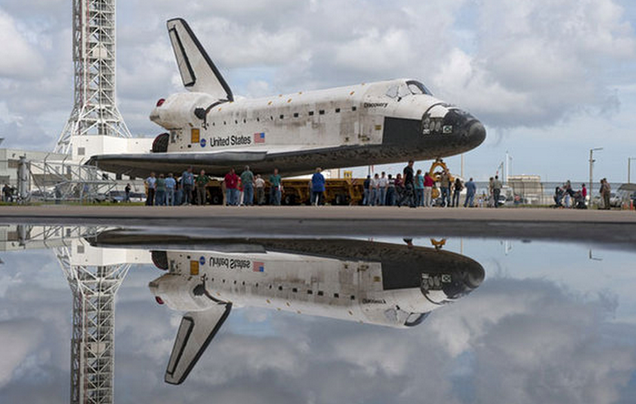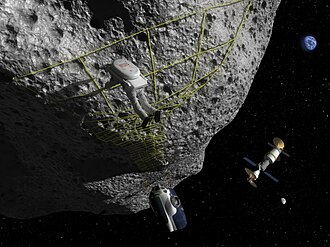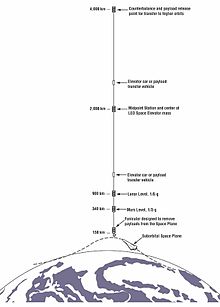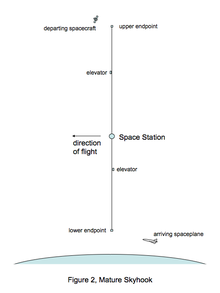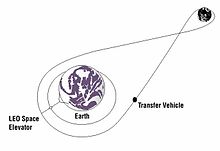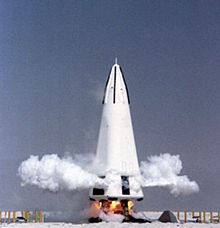From Wikipedia, the free encyclopedia
For Space Exploration Technologies Corporation, see
SpaceX.
Manned mission to a near Earth asteroid.
Space exploration technologies is about the ideas and
technologies that will enable the affordable movement of people and
goods from the surface of the Earth to orbit and beyond. It is about the
ideas and technologies that will allow mankind to explore, develop, and
colonize space.
Skyhooks and space elevators
A non-rotating Earth surface to geostationary orbit space elevator.
The generic term
space elevators refers to a group of three
proposed space transportation concepts that their promoters claim will
make Earth-to-orbit and interplanetary spaceflight affordable, thereby
opening the way for the commercial development of
lunar mining,
asteroid mining,
space-based solar power stations,
space colonies, and colonies on the
Moon,
Mars, and in the
asteroids.
These three concepts are:
A non-rotating Skyhook with approaching suborbital Spaceplane.
- a low Earth orbit non-rotating space elevator that does not reach down to the surface of the Earth (as described in section 3.2.1 of [1]) that is usually referred to as a non-rotating skyhook,
The suborbital approach, capture, and boost to higher orbit of a spacecraft by a rotating Skyhook.
- and a low Earth orbit rotating space elevator that also does not reach down to the surface of the Earth (as described on pages 2-4 of [2]) that is usually referred to as a rotating skyhook.
All three of these concepts have advantages and disadvantages. The most significant of them being:
- the rotating and non-rotating skyhooks can be built with currently
existing materials and technology while the Earth surface to
geostationary orbit space elevator cannot,
- the rotating and non-rotating skyhooks require a suborbital launch
vehicle to get the lower end of the tether while the Earth surface to
geostationary orbit space elevator does not, and
- the rotating and non-rotating skyhooks require either an
electrodynamic or an ion propulsion system for altitude control while
the Earth surface to geostationary orbit space elevator does not.
Of these three items the most important to remember is that both the
rotating and non-rotating skyhooks can be built with commercially
available materials while the Earth surface to geostationary orbit space
elevator cannot,
[2][3][4][5][6][7]
The following is a direct quote from "Space Elevators, An Advanced
Earth-Space Infrastructure for the New Millennium", a NASA Conference
Paper on all three space elevator concepts that was published in the
year 2000.
[1]
"The LEO space elevator [non-rotating skyhook] is an intermediate
version of the Earth surface to GEO space elevator concept, and appears
to be feasible today using existing high-strength materials and space
technology."
The following is a direct quote from "Hypersonic Airplane Space
Tether Orbital Launch System" (HASTOL), a NASA funded study on rotating
skyhooks.
[2]
"The fundamental conclusion of the Phase I HASTOL study effort is
that the concept is technically feasible. We have evaluated a number of
alternate system configurations that will allow hypersonic air-breathing
vehicle technologies to be combined with orbiting, spinning space
tether technologies to provide a method of moving payloads from the
surface of the Earth into Earth orbit. For more than one HASTOL
architecture concept, we have developed a design solution using
existing, or near-term technologies. We expect that a number of the
other HASTOL architecture concepts will prove similarly technically
feasible when subjected to detailed design studies. The systems are
completely reusable and have the potential of drastically reducing the
cost of Earth-to-orbit space access."
The following is a quote from Keith Henson, co-founder of the
L-5 Society regarding the Earth surface to geostationary orbit space elevator.
[3]
"No current material exists with sufficiently high tensile
strength and sufficiently low density out of which we could construct
the cable. There’s nothing in sight that’s strong enough to do it – not
even carbon nanotubes."
While no skyhook capable of capturing an arriving spacecraft has been built so far, there have been a number of
flight experiments exploring various aspects of the skyhook/
space tether concept.
[8]
Affordable spaceflight and skyhooks
The three most important issues that need to be addressed if a
transportation system is to be commercially affordable on a mass-market
level are:
- reusability,
- a low propellant fraction, and
- a high payload fraction.
Reusability so the investment can be amortized over a large number of
trips, a low propellant fraction for reduced operating costs, and a
large payload fraction so that the cost of each trip can be distributed
over a large amount of payload. Trains, planes, automobiles, trucks, and
ships are all very good examples of this. Currently existing
expendable rockets are not.
When a
launch vehicle
takes-off to go to Earth orbit, approximately 90% of its take-off
weight is propellant, 9% is the weight of the rocket, and 1% is the
weight of the payload.
[9]
With numbers like these it should be fairly obvious why the currently
existing expendable launch vehicles are somewhat of a failure when it
comes to meeting the three main requirements for a commercially
affordable mass-market transportation system. This is also why current
launch vehicles cost so much.
The reasons for this failure are threefold:
- the speed the rocket needs to achieve to reach Earth orbit,
- the amount of propellant it takes to achieve that speed (which has to do with the performance of the rocket motor), and
- the lack of reusability of the launch vehicle.
The
total speed
that a launch vehicle needs to achieve in order to reach low Earth
orbit is approximately 9,400 m/s. This includes the speed of low Earth
orbit, plus additional velocity for overcoming the force of gravity that
is trying to pull the rocket down, and additional velocity for the
atmospheric drag as the launch vehicle climbs through the atmosphere.
A skyhook makes spaceflight affordable by reducing the speed the
rocket needs to achieve in order to reach low Earth orbit. That
reduction in speed means less propellant is required. The reduction in
propellant allows the size of the payload to be increased. More payload
and less propellant per flight means a lower cost to orbit.
In order to provide some examples of how different sized reductions
in velocity translate into increased payload capacity, some simple
calculations were made using the
ideal rocket equation,
the 90% propellant, 9% rocket, and 1% payload ratio, and the 9,400 m/s
total speed for orbit value. The results of these calculations show
that:
- reducing the speed required for orbit by 200 m/s increases the payload size by over 50% and reduces the cost by over 33%,
- reducing the speed required for orbit by 400 m/s more than doubles the size of the payload and reduces the cost by over 50%,
- reducing the speed required for orbit by 800 m/s more than triples the size of the payload and reduces the cost by over 67%,
- reducing the speed required for orbit by 1,600 m/s increases the payload by a factor of 6 and reduces the cost by over 84%.
This process continues as the skyhook gets longer and applies to both rotating and non-rotating skyhooks.
Reusability of the launch vehicle
is the third key issue that needs to be addressed if a skyhook space
transportation system is to become commercially affordable on a
mass-market level. Using some of the increased payload capacity that the
skyhook makes possible to make the launch vehicle reusable is an idea
that is used and discussed in every reference in this article that
discusses either rotating or non-rotating skyhooks. The specific amount
of extra weight that will be required to make a launch vehicle reusable
will depend on the details of the launch vehicle design. Is it
single-stage-to-orbit,
two-stage-to-orbit, ground launched,
air launched,
catapult launched,
air-breathing, all rocket, or a
combination propulsion system?
All of these will have different requirements in order to make the
launch vehicle reusable. But regardless of the details, using some of
the increased payload capacity made possible by the skyhook to go from
an expendable launch vehicle to a reusable launch vehicle, will also be a
very important step in the process of making spaceflight mass-market
affordable: which is the whole purpose of a skyhook.
Non-rotating skyhooks
Non-rotating skyhook first proposed by E. Sarmont in 1990.
A non-rotating skyhook is a vertically oriented,
gravity gradient stabilized
tether whose lower endpoint does not reach the surface of the planet it
is orbiting. As a result it appears to be hanging from the sky, hence
the name skyhook. The idea of using a tidally stabilized tether for
downward-looking Earth observation satellites was first proposed by the
Italian scientist
Giuseppe Colombo.
[10]
The idea of using a non-rotating skyhook as part of a space
transportation system for Earth where sub-orbital launch vehicles would
fly to the bottom end of the tether, and spacecraft bound for higher
orbit, or returning from higher orbit, would use the upper end of the
tether, was first proposed by E. Sarmont in 1990,
[9] expanded on in a second paper in 1994,
[11] and in a third paper in 2014.
[12] Other scientists and engineers, as well as
NASA,
Lockheed Martin, former astronaut
Bruce McCandless II, and Dr.
Robert Zubrin, have also investigated, validated, and added to this concept.
[13][1][14][15][16][17][18][19][20][21]
In addition, NASA representatives who have reviewed this concept have
described it as, "The first idea we have seen that offers a believable
path to $100 per pound to orbit."
[22]
Basic 200 km long non-rotating skyhook.
[12]
Conceptually the main difference between a non-rotating skyhook and an Earth surface to geostationary orbit
space elevator
is that the non-rotating skyhook does not reach down to the surface of
the Earth. The lower end of the non-rotating skyhook is above the upper
edge of the atmosphere and requires a high-speed aircraft/sub-orbital
launch vehicle to get there. Since the lower end of the skyhook is
moving at less than orbital velocity for its altitude, a launch vehicle
flying there can carry a larger payload than it could carry to orbit on
its own.
[13] When the cable is long enough, single-stage to skyhook flight with a reusable sub-orbital launch vehicle becomes possible.
[1]
In addition, unlike a space elevator that remains over the same spot on
the Earth, a non-rotating skyhook circles the planet every few hours.
This allows the skyhook to serve as a terminal for sub-orbital launch
vehicles arriving from just about anywhere on Earth. This type of
skyhook can start out as short as 200 km and grow to over 4,000 km in
length using a bootstrap method that takes advantage of the reduction in
launch costs that come with each increase in tether length.
A visual comparison of the various non-rotating space elevator concepts that have been proposed.
At its longest, the non-rotating skyhook is approximately 1/25th the
length of the 100,000 km long space elevator. As a result, it is much
lighter in mass, and can be affordably built with existing commercially
available carbon fiber materials.
[1]
Analysis has also shown that this saving in construction cost for the
non-rotating skyhook more than makes up for the additional cost of the
sub-orbital launch vehicle that it requires. As a result, a mature
non-rotating skyhook with reusable single stage sub-orbital launch
vehicle is considered to be cost competitive with what is thought to be
realistically achievable using a space elevator,
[11] assuming a space elevator can ever be built.
[3][4][5][6][7]
Another advantage of the non-rotating skyhook is that once it is long
enough, the upper end of the cable as shown in figure 2, will be moving
at just short of escape velocity for its altitude. This means that a
spacecraft such as the
Orion spacecraft could be placed on either a free-return orbit to the Moon, or on course for a
near-Earth asteroid, without the need for an expensive expendable upper stage for boosting it to escape velocity.
[10][11][1]
Elimination of the expendable upper stage and all the propellant it
will require will also dramatically reduce the number of flights to the
lower end of the non-rotating skyhook, which will further reduce the
cost of such a mission.
This ability to capture sub-orbital launch vehicles coming up from
the Earth at the lower end of the cable, and to launch spacecraft to
higher orbits from the upper end of the cable, requires energy. Energy
that comes from either a solar powered
ion propulsion system[23] or an
electrodynamic propulsion system
on the skyhook. The advantage of this over current launch systems is
the greatly improved operating efficiency and reduced cost of either of
these propulsion systems compared to conventional expendable rockets.
[11][24]
While these high-efficiency, low-thrust propulsion systems cannot be
used for a planetary surface to orbit launch system due to their low
thrust, they are perfect for use on an orbiting skyhook due to their
ability to gradually store up energy by raising the orbital altitude of
the skyhook between arriving and departing flights.
The docking maneuver
The process of docking an arriving spacecraft at the lower end of the non-rotating skyhook starts with the skyhook in an
elliptical orbit. The low point of this elliptical orbit, the
perigee,
is selected so that the lower end of the skyhook cable will be at an
altitude of 185 km at that point in the orbit. The altitude of the high
point of the elliptical orbit, the apogee, is selected based on the mass
of the arriving spacecraft.
In addition to boosting the arriving spacecraft to the proper speed
and altitude for rendezvous, the sub-orbital launch vehicle for this
flight will also need to time its take-off so that it will rendezvous
with the lower end of the skyhook when the skyhook is at the low point
of its orbit.
When the arriving spacecraft docks with the lower end of the skyhook
it will lower the center of gravity of the total skyhook system, thereby
pulling the skyhook down into a lower more circular orbit. If the
apogee altitude of the skyhook's initial elliptical orbit was properly
selected, the skyhook will end up in a circular orbit after the arriving
spacecraft has docked.
Upon completion of the docking maneuver, the skyhook's solar-powered
ion propulsion system, or electrodynamic propulsion system, is activated
so as to start raising the orbital altitude of the skyhook back to its
original altitude.
What makes the skyhook concept work is energy exchange. When the
skyhook is in its initial elliptical orbit it is in a higher-energy
orbit than the one it ends up in after the arriving spacecraft docks
with the lower end of the skyhook. What happens is that the skyhook
gives the extra energy of the higher elliptical orbit to the arriving
sub-orbital spacecraft; a spacecraft that doesn't have enough energy to
remain in orbit on its own. The end result is that the arriving
spacecraft gets an energy boost from the skyhook that allows it to
remain in orbit while the skyhook gives up energy and drops to a lower
energy orbit. Before another arriving spacecraft can dock at the lower
end of the skyhook, the skyhook will need to use its high efficiency low
thrust propulsion system to raise itself back to the original
higher-energy orbit.
The Upper End of the Skyhook
Earth-Moon transfer via Non-rotating Skyhook.
The upper end of a mature Skyhook is designed to be moving at
slightly less than escape velocity for its altitude. What that means is
that a spacecraft departing from the upper end of the Skyhook can, with
the use of only a very small amount of onboard propellant, be headed for
geosynchronous orbit, on a
free return trajectory to the
Moon, on its way to one of the
Lagrange Points, or headed for a
Near Earth Asteroid. To put this in perspective, consider the
Saturn V
rocket that was used to fly to the Moon in the late '60s and early
'70s. The Saturn V had a take-off weight of 6,200,000 pounds. Its
payload to low Earth orbit was 260,000 pounds. Its useful payload to
Earth escape velocity was 100,000 pounds. Everything else, 6,100,000
pounds worth, was used up and thrown away. Now compare this to a mature
Skyhook launch system.
A passenger leaves Earth on a highly reusable suborbital spaceplane
that takes off from an airport and flies to the bottom end of the
Skyhook. The passenger transfers from the spaceplane to the Skyhook and
the spaceplane returns to Earth with a load of returning passengers and
cargo. The next step in the journey is a ride on the elevator up the
tether to the space station in the middle of the Skyhook where a
transfer is made to another elevator that is bound for the upper
endpoint. Nothing is thrown away, everything is reusable. At the upper
endpoint station the passenger transfers to a small reusable Earth-Moon
spacecraft that is similar to the
Apollo Command/Service Module,
which will take him/her to lunar orbit. The Earth-Moon spacecraft will
use a very small amount of onboard rocket propellant when it departs the
Skyhook, and will then fire its rocket motor a second time to slow down
to lunar orbit velocity when it arrives at the Moon. Upon arrival in
lunar orbit, the Earth-Moon spacecraft will rendezvous and dock with a
reusable single stage Lunar Lander that is carrying passengers and cargo
bound for Earth plus additional rocket propellant for the Earth-Moon
spacecraft. After the passenger, cargo, and propellant exchange is
complete, the Lunar Lander leaves lunar orbit and descends to the
surface of the Moon. Again, everything is reusable, nothing is thrown
away, and the rocket propellant for the Lunar Lander and the Earth-Moon
spacecraft comes from the Moon.
NASA is currently funding the development of a reusable Earth-Moon/Earth-Asteroid spacecraft that is similar to an
Apollo Command/Service Module called the
Orion spacecraft.
Combine this with a Skyhook and we will have an affordable
transportation system for traveling to Lunar orbit, the Earth/Moon
Lagrange points, and the near Earth asteroids. Add a single stage
reusable Lunar Lander and we will have an affordable transportation
system for going to the
Lunar surface. With access to Lunar and/or near Earth
asteroid materials, the building of a large, well shielded,
rotating,
Mars cycler spacecraft, or Ion powered Earth-Mars spacecraft, becomes possible, and safe regular affordable
interplanetary spaceflight to
Mars, the
Moons of Mars, as well as
Ceres and all the other
asteroids between Mars and Jupiter, becomes possible.
Patents
In the year 2000, Dr. Robert Raymond Boyd and Dimitri David Thomas
(with Lockheed Martin Corporation) applied for a patent on the
non-rotating Skyhook concept under the name "Space elevator". They were
granted a patent on this concept in 2002.
[6].
Critics of this patent question its legality due to the existence of
published materials on the non-rotating Skyhook concept that pre-date
the patent by 10 years.
A non-rotating skyhook transportation system for Mars
A non-rotating Skyhook transportation system for Mars
In 1984, Paul Penzo of
JPL
proposed a planetary surface to escape velocity tether transportation
system for Mars that consists of two non-rotating skyhooks; one attached
to the Martian moon
Phobos, and the other attached to the Martian moon
Deimos.
[25][26]
With this system, a spacecraft arriving at Mars, either direct from Earth, or from an
Earth-Mars cycler
spacecraft as it swings by Mars, docks at the upper end of the
non-rotating skyhook attached to the outer moon Deimos. The people and
cargo on that spacecraft then transfer to an elevator on the skyhook
that will take them down to the lower end of the Deimos skyhook. There
they board a small orbital transfer vehicle that will take them to the
upper end of the non-rotating skyhook that is attached to the inner moon
Phobos. Again they transfer to an elevator that will take them to the
lower end of the Phobos skyhook where they will transfer to the reusable
single stage Mars Lander that will carry them to the Martian surface.
Passengers and cargo from the Martian surface that are bound for either
the asteroids, or for Earth, would ride the system in reverse.
One of the advantages of this concept is that neither skyhook will
require a propulsion system for orbital re-boost or for orbit control,
as they both will use the Martian moon they are attached to as a
momentum bank to make up any discrepancies in the upward versus downward
mass flow of people and cargo. This elimination of the propulsion
systems for the two skyhooks also makes for a significant reduction in
the cost to build, and the cost to operate. Like the non-rotating
skyhook for Earth, this two-stage non-rotating skyhook system for Mars
can be affordably built with existing materials and technology.
Advantages and disadvantages of a non-rotating skyhook versus a rotating skyhook
- the non-rotating skyhook has a much larger rendezvous window for
arriving launch vehicles and spacecraft than the rotating skyhook which
makes for a much safer, more reliable, and easier to use system,
- the non-rotating skyhook allows for the separation of arrival and
departure operations at the lower end of the cable from the arrival and
departure operations at the upper end of the cable which adds
significantly to the operational flexibility of the system,
- when the non-rotating skyhook is long enough and the lower endpoint
velocity is low enough, single stage to skyhook flight with a reusable
sub-orbital launch vehicle becomes possible.
Rotating skyhooks
As the name implies, rotating skyhooks rotate end over end in the
plane of their orbit such that the upper endpoint becomes the lower
endpoint and the lower endpoint becomes the upper endpoint. In other
words, it rotates like a wheel that has two spokes and no rim.
When a rotating skyhook is placed in orbit around a planet, the
rotational direction is selected so that the lower endpoint of the
skyhook is moving slower than orbital velocity and the upper endpoint is
moving faster than orbital velocity. When the planet being orbited has
an atmosphere, the length and orbital altitude of the rotating skyhook
is selected so that the lower end of the cable is above the majority of
the atmosphere when it is closest to the ground.
[2]
The reasons for this are to minimize heating of the cable as it passes
through the upper part of the atmosphere, and so that a launch vehicle
flying to the bottom end of the rotating skyhook does not have to deal
with atmospheric buffeting while attempting to dock with the lower end
of the skyhook. The fact that the lower end of the cable has a
horizontal velocity of less than orbital velocity means that the launch
vehicle will not have to go as fast as it would if it were going
directly to orbit. Therefore, like the non-rotating skyhook, this
reduction in velocity increases the payload capacity of the launch
vehicle, thereby reducing the cost of getting into orbit. Once the
payload in the suborbital launch vehicle is captured by the lower end of
the rotating skyhook, it is carried up and around until the end of the
cable is at the top of its rotational arc where the payload is released.
When released, the payload will be moving faster than circular orbit
velocity for that altitude.
[27] This rotating skyhook/sub-orbital launch vehicle combination has also been referred to as 'Tether Launch Assist'.
[28]
Like the non-rotating skyhook, the rotating skyhook known as an 'Earth launch assist bolo':
- will need to be in a higher energy elliptical orbit prior to picking up the payload from an arriving launch vehicle
- will need a solar powered ion propulsion system, or electrodynamic
propulsion system, for re-boosting the rotating skyhook back to its
original orbit after lifting the arriving payload to a higher orbit
- will need to be at the low point of its elliptical orbit when the payload pickup is made
- will need a sub-orbital launch vehicle for carrying cargo and passengers to and from the lower end of the cable.
In addition, the rotational position of the lower end of the cable
will also need to be at the bottom of its swing when the rotating 'Earth
launch assist bolo' is at the low point of its elliptical orbit.
The Release Orbit. The primary purpose of a Skyhook is to
reduce the velocity required for orbit so as to increase the launch
vehicle's payload and thereby reduce the cost of getting into orbit. The
greater the velocity reduction, the greater the cost reduction.
With a rotating Skyhook, the greater the amount of velocity reduction
at the lower end, the greater the amount of excess velocity at the
upper end. In other words, if the rotating cable is moving at 90 percent
of circular orbit velocity for that altitude at the bottom of its
swing, it will be moving at more than 110 percent of circular orbit
velocity at the release point at the top of its swing. If the
destination orbit of the spacecraft being lifted is higher than that -
wonderful. However, if the destination orbit is lower, then the
spacecraft will need to use its onboard propulsion system to slow down
to get there. Obviously, a somewhat counter productive situation.
Unfortunately, the problem only gets worse as the velocity reduction
at the bottom gets larger. For example, when the length of the
hypersonic Skyhook has grown so that the lower end is moving at 60
percent of circular orbit velocity for its altitude, the release
velocity at the upper end will be in excess of escape velocity. In other
words, any spacecraft that desires to remain in Earth orbit will need
to use its onboard propulsion system to slow down in order to stay in
orbit.
This also causes a problem for interplanetary bound spacecraft.
Interplanetary travel requires both high velocity and precise course
control. In order for a spacecraft to go directly from high speed
suborbital flight to escape velocity, the launch will need to be timed
not just for the Skyhook cable being at the bottom of its swing, and the
Skyhook being at the low point of its baseline elliptical orbit, it
will also need to be timed and positioned so that the release orbit will
put the spacecraft on the necessary flight path for its destination.
Combining all these requirements together in one operation increases the
operational complexity of the flight to such a degree that success
becomes very questionable.
Rendezvous and capture. The following is direct quote from "Hypersonic Airplane Space Tether Orbital Launch System" (HASTOL).
[2]
"In any rotating tether transport system, one of the most
challenging tasks will be to enable the rendezvous between the payload
and the tether tip. For the tether to successfully capture the payload,
the payload and tether grapple vehicle must come together at nearly the
same place in space and time with nearly the same velocity. Because the
payload is in free fall, and the tether is rotating, the payload and
grapple vehicle will experience a relative acceleration equal to
a = V
t2/L
where Vt is the velocity of the tether tip relative to
the tether facility’s center of mass, and L is the distance from the
tether tip to the center of mass. In the HASTOL tether designs described
above, Vt is approximately 3.5 km/s, and L is approximately
500 km, so this acceleration is about 2.5 g’s. If neither grapple nor
payload perform any maneuvering, the two will coincide only
instantaneously, providing a minimal rendezvous window. Fortunately, it
is possible to extend this rendezvous window to five seconds or more by
using tether deployment from the grapple vehicle."
The
rendezvous
and capture of a payload at the lower end of a rotating skyhook happens
in five seconds or it does not happen. Compare this to the three to
five minutes that are available for rendezvous and capture with the
non-rotating skyhook.
[10]
When using a reusable launch vehicle to fly to the bottom of either a
rotating or non-rotating skyhook, a missed approach does not mean the
loss of a launch vehicle or payload. However, it does mean that the
mission will need to be re-flown with all the additional cost that
entails. As a result, critics of the rotating skyhook concept are
concerned, that due to the much shorter amount of time available for
rendezvous and capture, that the rotating skyhook will likely have a
much higher re-flight rate than the non-rotating skyhook. This is an
additional cost that will need to be accounted for when comparing the
two concepts. Fortunately this is an issue that NASA
Marshall Space Flight Center and
Tennessee Technological University have been working on.
[29]
Advantages and disadvantages of a rotating skyhook versus a non-rotating skyhook
- the overall length of a rotating skyhook is shorter than a
non-rotating skyhook for a given lower endpoint velocity thereby
allowing for a lighter weight tether,
- the much shorter rendezvous window for arriving launch vehicles at
the lower end of the rotating skyhook significantly increases the
likelihood of a missed approach,
- the rotating skyhook unavoidably links the upper end departure
operation with the lower end arrival operation which severely limits the
usability of the system when traveling to a higher orbit or to other
planets,
- when the lower endpoint velocity of the rotating skyhook is low
enough, single stage to skyhook flight with a reusable sub-orbital
launch vehicle becomes possible.
Zero velocity rotating skyhooks

Zero Velocity Skyhook. When the skyhook
rotation rate is synchronized with the skyhook's speed over the ground,
the end of the skyhook moves in a cycloid, and the endpoint is
momentarily stationary with respect to the ground. (Image from the
cycloid article.)
Another proposed method for using a rotating skyhook that is in orbit
around a small airless, or near airless body such as the Moon or Mars,
is to select the length and rotation rate of the skyhook such that the
lower end of the cable would have zero horizontal velocity relative to
the ground so that it could pick up payloads directly from the planetary
surface. These type of rotating skyhooks are called non-synchronous
skyhooks,
rotovators, or zero velocity rotating skyhooks.
Interplanetary skyhooks
A third type of rotating skyhook is one that is far from its parent
body, that rotates in the plane of the planets, and is used for
interplanetary spaceflight. An example of this would be a rotating
skyhook located at L-4, the leading Earth-Moon
Lagrangian point, that would be used to launch and receive small transfer spacecraft traveling to and from a
Mars cycler spacecraft as it swings by the Earth on it way to
Mars and the
asteroid belt again. This type of rotating skyhook is sometimes referred to as a free space skyhook,
bolo, interplanetary bolo, or interplanetary skyhook.
Hans Moravec
All three of these rotating skyhook concepts were first published by Dr.
Hans Moravec in 1977,
[30] expanded on in follow-on papers in 1978,
[31][32] and again in 1986.
[33] In his first paper he states that the idea for the rotating skyhook was conceived and suggested to him by
John McCarthy of
Stanford University.
[30] Other scientists and engineers, as well as
NASA,
Boeing,
Tethers Unlimited, Inc., Dr.
Robert Forward and Dr.
Robert P. Hoyt, have also investigated, validated, and added to the rotating skyhook concept.
[34][35][36]
Launch vehicles
McDonnell Douglas DC-X, a vertical take-off vertical landing reusable rocket.
Any orbital launch vehicle can fly to the lower end of either a
rotating or non-rotating skyhook, allowing it to both increase its
payload capacity and reduce its launch cost compared to flying directly
to orbit on its own. This applies to all existing
expendable launch systems, such as the
Atlas V,
Delta IV,
Falcon 9,
Antares,
Vostok,
Proton,
Long March, and the
Ariane V.
It also applies to
air launch to orbit launch systems such as the
Stratolaunch/
Pegasus II combination, or to proposed
reusable launch systems such as the
reusable Falcon 9,
New Shepard,
Skylon,
DC-X, a vertical take-off horizontal landing rocket powered spaceplane,
[37] a
rocket-based combined cycle powered
spaceplane,
[38] or the
scramjet-powered
Rockwell X-30.
Additional advanced launch vehicle concepts that could also benefit from using a skyhook can be seen here.
[39]
While Virgin Galactic's SpaceShipTwo currently does not fly high
enough or fast enough to reach the lower end of either a rotating or
non-rotating skyhook, it does provide an idea what space flight to a
skyhook might look like in the near future.
Combination launch systems
A rotating tall tower launching a suborbital rocket to the lower end of a non-rotating Skyhook.
A high speed ground accelerator for launching suborbital spacecraft to orbit, or to the lower end of a non-rotating Skyhook.
In 1999, in the workshop that lead to the NASA conference paper
"Space Elevators, An Advanced Earth-Space Infrastructure for the New
Millennium",
[1] the idea of combining some kind of
ground accelerator,
rocket sled, or
catapult
with a non-rotating skyhook was proposed as a way of further reducing
the propellant fraction of the sub-orbital launch vehicle so as to
increase its payload fraction and further reduce the cost of getting to
orbit.
In 2009, Dr. Dana Andrews of the
University of Washington,
went into more detail regarding a possible combination non-rotating
skyhook and catapult system in pages 6 through 12 of a presentation he
gave at the 'Advanced Space Technology Workshop' at NASA Langley.
[20]
In addition to the catapult further reducing the propellant fraction of
the sub-orbital launch vehicle, another way of taking advantage of this
combination system would be to use it to reduce the startup cost of
building an initial skyhook system by off-loading some of the launch
vehicle velocity reduction to a cheaper to build ground accelerator
which then allows for a shorter and less expensive skyhook in the
beginning. The trackless ground accelerator shown in this presentation,
which builds on the
winch launch system used by
sailplanes,
is potentially one very low cost method for doing this. Another
possible low cost ground accelerator idea for use with a skyhook would
be a rail system like the
Holloman High Speed Test Track which currently holds the
land speed record for rail vehicles of
Mach 8.6, or 9,465 ft/s (2,885 m/s).
The idea of adding some type of ground accelerator or catapult to a launch system is not new.
[40] The
Wright brothers used a catapult to help get the
Wright Flyer
up to take-off speed for its first flights. The U.S. Navy uses them to
launch aircraft off of aircraft carriers on a daily basis. They have
also been used in a number of science fiction stories and movies for
launching spacecraft into orbit.
Air launch to orbit,
where an airplane is used to carry the launch vehicle up to 30,000 to
40,000 feet of altitude before launch, is another launch method that
could be used as part of a combination skyhook launch system.
A recent development in the world of ground assisted launch is a
project called VALT, which stands for Vertical Accelerator Launch Tower.
For more information on VALT go to
[41]
Best orbit for a skyhook
The two most commonly proposed orbits for either a rotating or non-rotating skyhook are the
plane of the equator and the
plane of the planets,
[42] also known as the plane of the ecliptic.
The advantage of an equatorial orbit is that it allows for frequent
revisit opportunities between a near-equatorial launch and landing site
and the lower end of the skyhook. This is especially important if the
ground site includes a ground accelerator or catapult for giving the
sub-orbital launch vehicle its initial boost. The disadvantage of the
equatorial orbit is that a spacecraft using the upper end of the skyhook
for interplanetary travel will most likely require a
plane change maneuver.
The advantage of the skyhook orbit being in the plane of the planets
is that it avoids the need for a plane change maneuver when going
interplanetary or when launching a spacecraft from the upper end of the
skyhook to rendezvous with a Mars cycler as it swings by the Earth. The
disadvantage of this orbit is the greatly reduced frequency of launch
opportunities from a fixed ground site to the lower end of the skyhook.
As a result, use of this orbit would most likely drive the design of the
sub-orbital launch vehicle to an
air launch to orbit system like
Stratolaunch but with a single stage reusable launch vehicle.
Navigating a skyhook
Navigating a skyhook and controlling the location of the
low point of its orbit, its
orbital eccentricity, and its
average orbital altitude
will be very different from any other Earth orbiting satellite or
spacecraft that has been put in orbit before. The primary difference
between a skyhook and previous orbital vehicles is that the skyhook will
be under almost continuous acceleration and as a result its perigee
location, eccentricity, and average altitude will be in a near-constant
state of change. This applies to both rotating and non-rotating skyhooks
regardless of their overall length and
inclination of orbit. For a skyhook in an orbit that is inclined to the plane of the equator there will also be the additional issue of
nodal precession
and how to manage the change in the orbital plane this causes so that
the skyhook will be in the desired orbital plane at the right time for
launching a vehicle from the upper end of the skyhook. Another
significant issue regarding the navigation of a skyhook is the low
thrust to weight ratio of the skyhook propulsion system and the
resulting low rate of acceleration. It is due to this low rate of
acceleration that every spacecraft arrival at the lower end of the
skyhook, every return to Earth from the lower end of the skyhook, and
every launch to a higher orbit from the upper end will need to be
planned many months in advance and coordinated with other planned
arrivals, departures, and upper endpoint launches in order to make sure
the skyhook is in the right place at the right time so as to fulfill
each specific mission and to maximize the utilization of the skyhook.
Control of all these factors is made possible by the skyhook's
propulsion system and by planning in advance so as to minimize the total
change in velocity required by the skyhook to accomplish the various
missions. Some of the possible control methods for accomplishing this
are:
- vectoring and varying the thrust of the ion propulsion system
- pausing for a period of time in a specific orbit that has an orbital
period or nodal precession rate that allows the skyhook to end up in
the desired orbit at the desired time
- timing the release of refuse from the lower end of the skyhook into a
re-entry orbit such that the resulting change in orbit to the skyhook
assists in the navigation to the desired orbit at the desired time.
The journey to Mars and beyond
Between 1954 and 1963, the Director of NASA Marshall Space Flight Center's Space Sciences Laboratory,
Ernst Stuhlinger, proposed three different Ion powered spaceships for manned expeditions to Mars.
[43][44][45]
The first of these concepts was solar powered, while the second and
third were nuclear powered. All three of these concepts would take
approximately two months to slowly accelerate out of low Earth orbit to
escape velocity, and then continue accelerating in solar orbit until
they were half way to Mars where they would then turn around and begin
decelerating into high Mars orbit. The transfer time in solar orbit,
from Earth escape velocity until arriving at high Mars orbit, was 5
months. After that they would take an additional month to slowly spiral
down to low Mars orbit. Videos of two of the three Ion powered
spaceships designed by Ernst Stuhlinger, the Sun Ship, and the Mars
Umbrella Ship, can be seen at
[46] for the Sun Ship, and
[47] for the Mars Umbrella Ship.
Outpost space stations
A possible outpost station at the Earth-Moon L2 Lagrange point.
In 1984, Paul Keaton of the Los Alamos National Laboratory wrote a
paper about the need for outposts in space along the routes to the
planets and other places of interest.
[48]
These outposts to be warehouses for propellant, spare parts and
supplies, rest stations for crew members, and transshipment sites for
cargo. The first outpost to be a space station in low Earth orbit. For
the second outpost he proposed two possible locations; the Sun-Earth L1
Lagrange point, or the Earth-Moon L2 Lagrange point. Both of these locations are relatively easy to reach, and both allow the use of
gravity assist
maneuvers by departing spacecraft as they pass by the Moon and Earth on
their way to the next outpost, Mars, or beyond. He also proposed that
the third outpost be located at the Sun-Mars L1 Lagrange point where it
would serve as the departure point for trips to the Martian moons, low
Mars orbit, the asteroids, and return trips to Earth. Since these
outpost stations will be located on the
Interplanetary Transport Network
they will also support the low energy transfer of equipment and
supplies that can be sent ahead on an unmanned cargo vessels prior to
the departure of the high speed crewed vessel.
Another one of the advantages of the outpost concept is the way it
breaks up the journey into segments. For example, once both the second
and third outpost stations are in place and local sources of propellant
are established for each, Mars bound spacecraft that travel between
these two stations will only need to carry enough propellant for a
one-way trip on this segment and not for the entire round-trip journey
to Mars as they would without the outpost stations. This allows the
spacecraft to carry a much larger payload fraction and to be designed as
a completely reusable vehicle - two features that will greatly reduce
the cost of interplanetary spaceflight.
Nautilus-X Extended duration explorer
As with so many proposed space transportation concepts the question
usually becomes, "How real is it?" For the outpost space station concept
it is interesting to note that Nasa has funded three different design
studies for the building of such an outpost at the Earth-Moon L2
Lagrange point called
Deep Space Habitat,
Exploration Gateway Platform, and
Skylab II. Also of note, in 2011, Nasa's
Technology Applications Assessment Team presented a concept for a manned deep space exploration spacecraft called
Nautilus-X
that would be perfect for trips departing from an Earth-Moon L2 outpost
station bound for either a near Earth asteroid, Mars, or beyond. This
spacecraft could be powered by either a solar powered ion propulsion
system similar to that used on Ernst Stuhlinger's Sun Ship, or a nuclear
electric ion propulsion system as used on his Mars Umbrella Ship. Other
possible propulsion systems for this vehicle are
VASIMR, a mass driver propulsion system, or existing chemical rocket motors.
Local sources of propellant
Orion at the captured asteroid
A key ingredient that the outpost stations will need to supply if
they are to make interplanetary spaceflight mass market affordable will
be local sources of propellant. Nasa has been working on the solution to
this with it's
Asteroid Redirect Mission.
This is the mission that will move a small asteroid into Lunar orbit.
It is this asteroid that will also be the destination of the first
manned mission on the Orion spacecraft once the asteroid has arrived in
Lunar orbit. For more information on this Orion mission see
Exploration Mission 2.
It is this asteroid redirect technology that will allow small asteroids
to be moved to Outpost Station 2 at the Earth-Moon L2 Lagrange point
and to Outpost Station 3 at the Sun-Mars L1 Lagrange point, and it is
these asteroids that will be the local sources of propellant for
Nautilus-X on its voyages of exploration around the inner solar system.
It almost doesn't matter what the asteroids are made of as just about
anything will work for propellant. If the asteroid has a lot of water
ice the water could be made into LOX and LH2 for chemical rocket motors.
Another option is to use the hydrogen for a VASIMR propulsion system. A
third option would be to grind up the rocky material and use it as
reaction mass with a
mass driver propulsion system as proposed by
Gerard K. O'Neill
In conclusion
It is interesting to think about what a near future space transportation system based on all these concepts might look like.
- a reusable suborbital launch vehicle for flying to the lower end of a Skyhook
- a Skyhook in Earth orbit
- the Orion spacecraft for manned spaceflight beyond the upper end of a Skyhook
- an outpost space station at the Earth-Moon L2 Lagrange point
- robotic asteroid retrieval spacecraft
- Lunar landers and mass drivers for moving people and cargo between the outpost station and the moon
- and Nautilus-X for voyages of exploration to the near Earth asteroids, Mars, and maybe even to the main belt asteroids.
Once this system is in place we will be able to build the third
outpost space station at the Sun-Mars L1 Lagrange point, and the two
non-rotating skyhooks that will be attached to the two Martian moons
Phobos and Deimos. All of which will further reduce the cost of getting
to Mars and will make all the dreams for the
Colonization of Mars and the
Terraforming of Mars into reality.
Skyhooks in fiction
- A non-rotating skyhook was constructed during the events of Jack McDevitt's novel Deepsix.
- In the anime Bubblegum Crisis: Tokyo 2040,
the three main protagonists arrive at the series' climactic battle with
Galatea in Earth orbit by commandeering a skyhook transit system.
- Turn-A Gundam,
anime series, depicts an ancient hypersonic skyhook which has been
maintained operationally by nanomachines over thousands of years. An
ancient mass driver is also used for transporting space-vessels from
earth's surface to the skyhook.
- In the Star Wars expanded universe, skyhooks are common above Coruscant. They are frequently private retreats owned by corporations or wealthy individuals.[citation needed]
- In the LucasArts video game Star Wars: The Force Unleashed a skyhook is being constructed on the planet Kashyyyk.
- The planet of Tara K. Harper's Grey Ones
series features a number of skyhook stations. The tethers are
apparently no longer functioning, but large terminal structures still
exist.[citation needed]
- A skyhook figures prominently in Arthur C. Clarke's posthumous novel The Last Theorem, which he co-wrote with Frederik Pohl.
The novel describes the skyhook as a means of interplanetary travel
rather than simply a means to reach orbit. It is used as a means of
transport by athletes and delegates to the "first-ever lunar Olympics".
- Skyhook construction is a central theme in the science fiction novel The Barsoom Project, the second book in the Dream Park series, by Larry Niven and Steven Barnes. The destructive potential of a falling skyhook is also explored, and the potential for this to be exploited by terrorists.
See also






